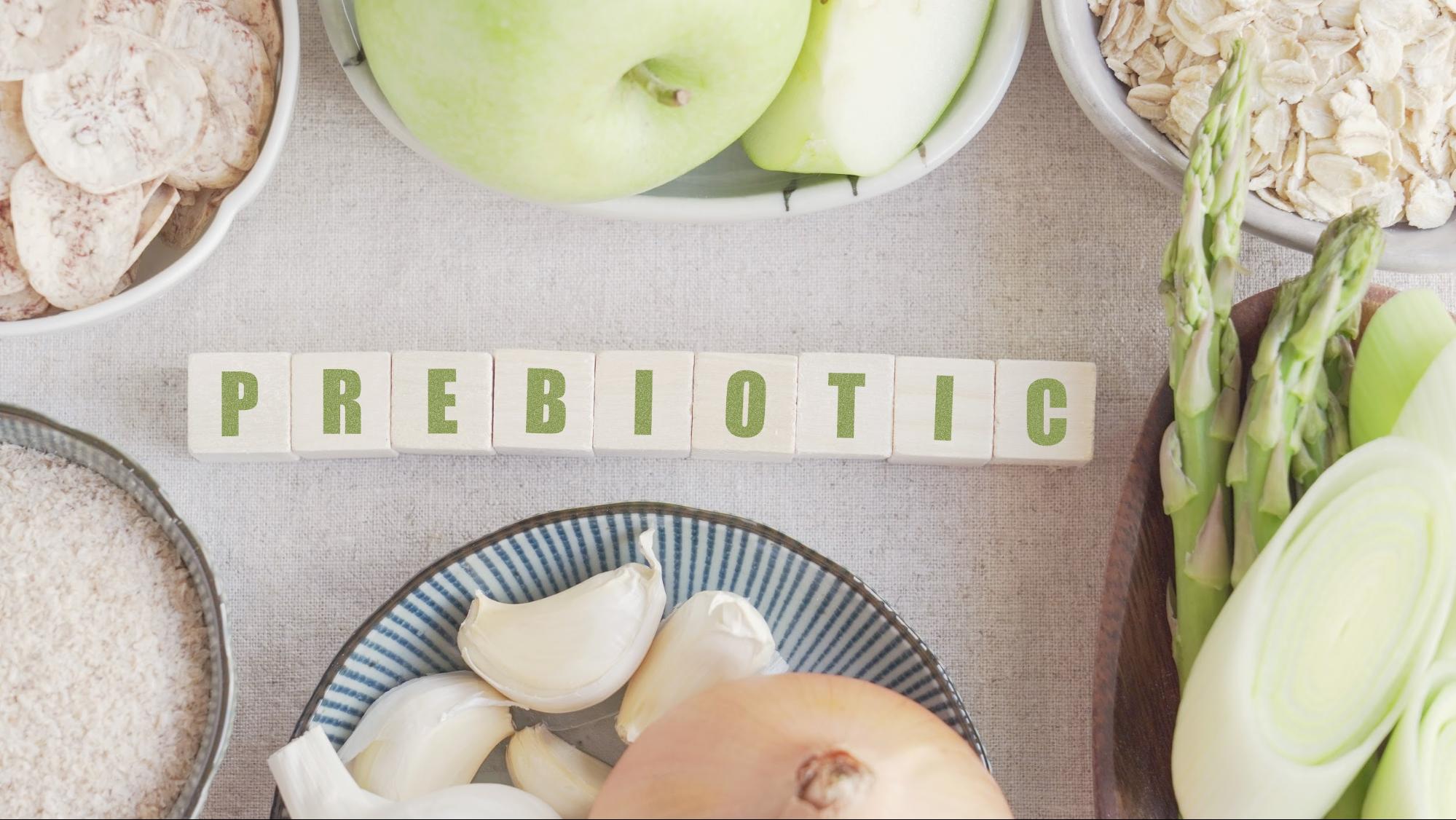Prebiotics are indigestible fibers that are the food sources for the trillions of beneficial bacteria and yeast living in the human gut.
The beneficial bacteria in our gut are often referred to as “probiotics” and help regulate digestive health and many essential processes in the human body. As such, prebiotics are an important partner for probiotics and a necessary component for a healthy digestive system and overall wellbeing.
Fibers are long chains of carbohydrate sugars that break down slowly and provide sustained energy.
The most common prebiotic fiber is inulin and it's produced in over 36,000 types of plants. Other typical forms of prebiotics are oligosaccharides, fructo-oligosaccharides, galacto-oligosaccharides, and resistant starch.
You can get these fibers from food, such as leafy vegetables, whole grains and legumes.
Unfortunately, it is estimated that only 5% of Americans meet the recommended daily fiber intake.
Prebiotic vs Probiotic: What’s the Difference?
It can be easy to confuse the two terms, but there is a difference between prebiotics and probiotics.
Probiotics are the beneficial bacteria that live in your intestines. They help regulate your digestion and metabolism, support immune function and even cognition and mood.
Prebiotics are simply strong plant fibers you eat but can’t digest, but the bacteria can.
Probiotics need that food source to flourish into healthy bacteria and beat out the negative bacteria in your gut. When prebiotics and probiotics are taken together, they are considered a “synbiotic,” a superior product giving the beneficial bacteria a stronger chance of survival and growth in the digestive tract.
Interestingly, different probiotic bacteria prefer different prebiotic food sources, which is why it’s important to consume a diverse set of fibers.
There’s one more reason why prebiotics are so important: a lot of beneficial bacteria cannot be taken as a probiotic supplement, because they are anaerobic (oxygen is harmful to them) and can’t survive outside the gut. So, the only way to help them become a stronger part of your gut ecosystem is to feed them what they need from the inside: prebiotics!
How Do Prebiotics Help with Gut Health?

Prebiotic fibers are mostly too tough and indigestible for humans. They don’t break down in the stomach, but travel all the way down to the large intestine. Here, they are fermented by bacteria and yeast, producing short-chain fatty acids (SCFAs) that the gut bacteria then consume.
Prebiotics have a fantastic effect on the gut because those SCFAs tend to feed only helpful bacteria, while inhibiting potentially harmful or unwanted microorganisms. This is due to the lower pH level that occurs in the colon as a result of the fermentation process, which harms pathogens (bad bacteria, viruses, and fungi) and helps bacteria like lactobacilli and bifidobacteria.
By increasing the amounts of helpful bacteria relative to those of harmful bacteria, prebiotics have an indirect and powerful effect on the microbiome and how it affects the body, with or without the addition of probiotic supplements or fermented foods like kimchi, sauerkraut, or yogurt.
Every benefit that probiotics provide the body can be supported and enhanced by the consumption of prebiotics. Studies even show that those effects often come down to the specific type of prebiotic consumed.
For example, lactulose has a stronger effect than other types of prebiotic on the improvement of calcium absorption. The type of prebiotic you consume may have a direct influence on a positive outcome in your health.
Brain Function
As mentioned above, one of the reasons to take prebiotics is that they are key in supporting probiotics in the body. Probiotics can help improve mood, memory, and learning and adding a prebiotic may help.
Several clinical studies show positive effects on the nervous system after the administration of a prebiotic, most significantly in recall and memory in adults, depending on the kind of prebiotic taken.
Fructooligosaccharides (FOS) and Glucooligosaccharides (GOS) specifically help regulate neurotransmitters, synaptic proteins, and neurotrophic factors.
Irritable Bowel Syndrome (IBS)

Numerous studies with probiotics have shown a conclusive improvement in the symptoms of IBS patients, particularly with strains of Lactobacillus and Bifidobacterium.
Patients with IBS have a marked lack of bifidobacteria, so the addition of prebiotics alone, without the introduction of new bacteria, would leave little if anything for the prebiotic to work on.
This may be why early studies with prebiotics alone have not confirmed any change in IBS symptoms. When prebiotics are taken as a synbiotic together with probiotics, the probiotic bacteria have a greater chance of reproducing in the system.
Immune System
Prebiotics help Lactobacillus and Bifidobacterium flourish in the gut. These two friendly bacteria are extremely important in the functioning of the immune system. Notably, the intestines are the largest immune organ in the body and gut health affects immunity.
Prebiotics also increase immunity molecules like cytokines. Furthermore, when taken with a viral vaccine, prebiotics improved the body’s antibody response.
Health Benefits of Prebiotics
Prebiotics aren’t merely a food source which assist the microbiota to flourish. The short-chain fatty acids (SCFAs) they become after fermentation also have several important direct effects on the body.
Those SCFAs are small enough to enter the bloodstream, and travel to organs throughout the body, where they’re used as an energy source for numerous different processes. The most common types of SCFAs produced are butyrate, propionate, and acetate.
Gut Wall Health
The cells on the colon wall prefer to use butyrate for energy even when there are other forms of energy available to them (like glucose). Butyrate also may help to protect against colon disorders.
Brain Function
The brain, muscles, and tissues use acetate as an alternative energy source to glucose.
Cholesterol Levels and Liver Function
Propionate is a precursor to the generation of glucose in the liver, and studies show it may also interfere with the creation of cholesterol in the liver, helping to keep levels low.
Benefits of Prebiotic Fiber
One other method in which prebiotics serve the body is by acting as a fiber. While all prebiotics are fiber, not all are classified as dietary fiber.
Recently, however, oligosaccharides have earned this label, since they have been shown to produce the same physiological effect as dietary fiber.
Blood Sugar Regulation
All dietary fiber helps to control blood sugar levels by slowing down the rate of glucose absorption. There is strong evidence showing that increased fiber consumption leads to significantly lower diabetes risk.
This means that your prebiotic inulin, fructo-oligosaccharides, and all other oligosaccharides in your diet will help to control blood sugar levels and prevent diabetes.
Weight Loss

Prebiotic fiber helps manage weight gain by inducing a feeling of being full and curbing your appetite. Fiber takes longer to chew, which increases saliva and gastric acid, causing the stomach to distend and triggering a feeling of fullness.
Other fibers cause the stomach to empty more slowly, which may also create the sensation of being full.
One study on Chinese adults showed that the prebiotic wheat dextrin significantly reduced hunger between meals, and the amount of calories the participants consumed per day.
But prebiotics go further than just acting as fiber when it comes to preventing obesity. There is a marked difference in the ratio of gut Bacteroidetes relative to Firmicutes when gut flora of lean and obese people are compared.
Another study showed that women who ate more fiber had a reduced chance of gaining weight.
Leaner people have a higher quantity of Bacteroidetes than they do Firmicutes, and when people lose weight, their gut flora changes in just this way.
Prebiotic Foods List

Plants are a wonderful natural source of prebiotics since they are generally built from fiber, or they produce it to store energy long-term.
The best place for them to put that excess energy is in the root, so prebiotics are commonly found there in the highest amounts, but they exist in many other plants as well.
The following is a list of prebiotic plant sources which type they contain. Notably, human breast milk contains its own prebiotics and is the best source for infants.
Root Vegetables
| Chicory Root | 47% inulin, oligofructose |
| Jerusalem Artichoke | inulin |
| Konjac Root | glucomannan |
| Burdock Root | inulin |
| Yacon Root | inulin, FOS |
| Jicama Root | inulin |
| Garlic | inulin, FOS |
| Onion | inulin, FOS |
| Leeks | inulin |
Stems/Greens
| Asparagus | inulin |
| Dandelion Greens | inulin, FOS |
| Seaweed | polysaccharides (prebiotic effect) |
Fruits
| Bananas | inulin (and resistant starch when unripe) |
| Apples | 50% pectin |
| Tomatoes | FOS |
| Berries | polyphenols |
Whole Grains
| Barley | beta-glucan |
| Oats | beta-glucan fiber |
| Wheat Bran | inulin, FOS, arabinoxylan-oligosaccharides (AXOS) |
Seeds
Legumes
Fermented Foods
Fermented foods like sauerkraut and kimchi are synbiotic. They often include onions and garlic (which are good sources of prebiotics), and the fermentation process enhances the number of live beneficial organisms, especially Lactobacillus.
Identifying Prebiotic Foods

Now that you know how helpful prebiotics are in your diet, you might want to start looking for them in the grocery store. Use the above list when shopping for whole food items, and remember that roots and apples are an easy way to get the most amount of prebiotics per gram.
If you’re looking at premade items with multiple ingredients like cereals, soups, granola bars, and the like – take a look at the food ingredients on the Nutrition Facts label.
If it lists chicory fiber, inulin, fructooligosaccharides, galacto-oligosaccharides, or oligofructose, then it is a good source of prebiotics.
Since many prebiotics have been reclassified as fiber, in recent years the FDA has begun to not detail the specific prebiotic, but simply changed the fiber quantity on the item. So, if a food has a high amount of fiber, it will likely also be beneficial to your gut health, even if the prebiotic levels aren’t as high in it as they are in some other foods.
Prebiotic Side Effects
Prebiotics are generally safe for healthy adults, but they can have some mild side effects. When taken at a low dose, some people can experience flatulence, and when taken at a high dose, some experience diarrhea.
But a low dose (2.5-10 g/day) is enough to generate a beneficial impact on human health, and not everyone will experience side effects. Nevertheless, people who already have a gastrointestinal disorder, such as IBS, SIBO, or FODMAP, must be careful when consuming prebiotics.
If the prebiotic fibers ferment too rapidly, it can introduce bloating and constipation along with the aforementioned gas and diarrhea.
It is worth mentioning that prebiotics with longer carbohydrate chain length demonstrate fewer side effects, since they ferment and produce gas less rapidly.
As mentioned, the type and dose of prebiotic consumed can have an enormous difference upon the effect recorded.
One study on IBS patients showed a reduction in flatulence severity when using a low dose of non-inulin prebiotics, and two other studies at a dose of 5 g per day noted improvement, while a study using 20g per day did not.
It would seem that using just a little - for IBS patients - can start to slowly help increase the quantity of probiotics in their system without aggravating their intestinal symptoms.
Do They Only Feed the Good Bacteria?
Studies show that while some harmful bacteria may feed off prebiotics, they won’t be able to multiply significantly due to the pH change in the gut when good gut bacteria like Lactobacillus and Bifidobacterium start fermenting the prebiotic.
Our body’s helpful bacteria also produce antibodies which immediately begin to battle microbes and pathogens, even in the colon. And once they increase, they leave little space behind for the bad bacteria to exist and multiply.
So while there might be a very small increase in the population of harmful bacteria, the good bacteria will multiply by a much greater amount. Your gut ecosystem is healthy when the ratio of good bacteria vastly outweighs the bad.
Can You Take Prebiotics and Probiotics Together?

Absolutely! Prebiotics and probiotics can and should be taken together.
Some probiotic supplements contain a small amount of prebiotics. This serves as food for the probiotic bacteria, and strengthens these live microorganisms for their way through the gastro-intestinal tract to the intestines.
However, this is typically not enough prebiotics to also feed all the good bacteria in the gut. That’s why it can be beneficial to also take a prebiotic supplement.
In this case, the best time to take the prebiotic supplement is a few minutes apart from the probiotic so that fermentation doesn’t begin before they meet in the large intestine and cause discomfort. Start by taking the probiotic on an empty stomach. Prebiotics may be taken 10 to 15 minutes afterward.
What is the Correct Prebiotic Dosage?
The best dosage of prebiotic for the average person to consume on a daily basis is around 2.5 to 10 grams. This is the level at which positive effects on the gut microbiome and the rest of the body begin to be seen. It also makes sense to start slowly and work up to the recommended dose, as to not overwhelm your digestive system.
What is the Best Prebiotic Supplement?
Different probiotic bacteria prefer different fibers as food sources. That’s why OMNi-LOGiC are precision prebiotics, developed with specific health outcomes in mind.
OMNi-LOGiC PLUS, for example, contains specific fibers that contribute to the normal function of digestive enzymes and to maintain healthy mucous membranes in the intestines. This aids digestion and bowel movements, and can contribute to weight loss.
It’s also an ideal source of important fibers and nutrients for important anaerobic intestinal bacteria such as Akkermansia muciniphila and Faecalibacterium prausnitzii.
OMNi-LOGiC IMMUNE combines valuable dietary fibers with important vitamins and minerals, to promote the health and reproduction of essential anaerobic probiotic bacteria and to strengthen the immune system via the gut. This prebiotic also has anti-inflammatory properties.
Our Prebiotics
Sources
Pandey, K. R., Naik, S. R., & Vakil, B. V. (2015). Probiotics, prebiotics and synbiotics - a review. Journal of Food Science and Technology, 52(12), 7577–7587. https://doi.org/10.1007/s13197-015-1921-1
Medical terms simply explained. (2020). Retrieved from https://www.omni-biotic.com/en/gut-wiki/
Davani-Davari, D., Negahdaripour, M., Karimzadeh, I., Seifan, M., Mohkam, M., Masoumi, S. J., Berenjian, A., & Ghasemi, Y. (2019). Prebiotics: Definition, Types, Sources, Mechanisms, and Clinical Applications. Foods (Basel, Switzerland), 8(3), 92. https://doi.org/10.3390/foods8030092
Slavin J. (2013). Fiber and prebiotics: mechanisms and health benefits. Nutrients, 5(4), 1417–1435. https://doi.org/10.3390/nu5041417
Neis EPJG, Bloemen JG, Rensen SS, van der Vorst JR, van den Broek MA, Venema K, et al. (2016). Effects of Liver Resection on Hepatic Short-Chain Fatty Acid Metabolism in Humans. PLoS ONE 11(11): e0166161. https://doi.org/10.1371/journal.pone.0166161
Yan, F., & Polk, D. B. (2011). Probiotics and immune health. Current Opinion in Gastroenterology, 27(6), 496–501. https://doi.org/10.1097/MOG.0b013e32834baa4d
Jiang, L., Gulanski, B. I., De Feyter, H. M., Weinzimer, S. A., Pittman, B., Guidone, E., Koretski, J., Harman, S., Petrakis, I. L., Krystal, J. H., & Mason, G. F. (2013). Increased brain uptake and oxidation of acetate in heavy drinkers. The Journal of Clinical Investigation, 123(4), 1605–1614. https://doi.org/10.1172/JCI65153
Guérin-Deremaux L, Pochat M, Reifer C, Wils D, Cho S, Miller LE. (2011). The soluble fiber NUTRIOSE induces a dose-dependent beneficial impact on satiety over time in humans. Nutrition Research, 31(9), 665-72. https://doi.org/10.1016/j.nutres.2011.09.004
Tucker L.A., Thomas K.S. (2009). Increasing total fiber intake reduces risk of weight and fat gains in women. The Journal of Nutrition, (139), 576–581. https://doi.org/10.3945/jn.108.096685
Castaner, O., Goday, A., Park, Y. M., Lee, S. H., Magkos, F., Shiow, S., & Schröder, H. (2018). The Gut Microbiome Profile in Obesity: A Systematic Review. International Journal of Endocrinology, 2018, 4095789. https://doi.org/10.1155/2018/4095789
Alanna J. Moshfegh, James E. Friday, Joseph P. Goldman, Jaspreet K. Chug Ahuja. (1999). Presence of Inulin and Oligofructose in the Diets of Americans. The Journal of Nutrition, 129(7), 1407S–1411S. https://doi.org/10.1093/jn/129.7.1407S
Samal L, Chaturvedi VB, Saikumar G, Somvanshi R, Pattanaik AK. Prebiotic potential of Jerusalem artichoke (Helianthus tuberosus L.) in Wistar rats: effects of levels of supplementation on hindgut fermentation, intestinal morphology, blood metabolites and immune response. J Sci Food Agric. 2015 Jun;95(8):1689-96. https://doi.org/10.1002/jsfa.6873
Lopez-Santamarina, A., Miranda, J. M., Mondragon, A., Lamas, A., Cardelle-Cobas, A., Franco, C. M., & Cepeda, A. (2020). Potential Use of Marine Seaweeds as Prebiotics: A Review. Molecules (Basel, Switzerland), 25(4), 1004. https://doi.org/10.3390/molecules25041004
Falcomer, A. L., Riquette, R., de Lima, B. R., Ginani, V. C., & Zandonadi, R. P. (2019). Health Benefits of Green Banana Consumption: A Systematic Review. Nutrients, 11(6), 1222. https://doi.org/10.3390/nu11061222
Wing Sun Faith Chung, Marjolein Meijerink, Birgitte Zeuner, Jesper Holck, Petra Louis, Anne S. Meyer, Jerry M. Wells, Harry J. Flint, Sylvia H. Duncan. (2017). Prebiotic potential of pectin and pectic oligosaccharides to promote anti-inflammatory commensal bacteria in the human colon. FEMS Microbiology Ecology, 93(11). https://doi.org/10.1093/femsec/fix127
Sorrenti, V.; Ali, S.; Mancin, L.; Davinelli, S.; Paoli, A.; Scapagnini, G. (2020). Cocoa Polyphenols and Gut Microbiota Interplay: Bioavailability, Prebiotic Effect, and Impact on Human Health. Nutrients, 12, 1908. https://www.mdpi.com/2072-6643/12/7/1908
Staub, D. (2020). What You Need to Know About Prebiotics. Retrieved from https://columbiasurgery.org/news/2017/02/09/what-you-need-know-about-prebiotics
Wilson B, Rossi M, Dimidi E, Whelan K. (2019). Prebiotics in irritable bowel syndrome and other functional bowel disorders in adults: a systematic review and meta-analysis of randomized controlled trials. The American Journal of Clinical Nutrition, 109(4):1098-1111. https://doi.org/10.1093/ajcn/nqy376.




